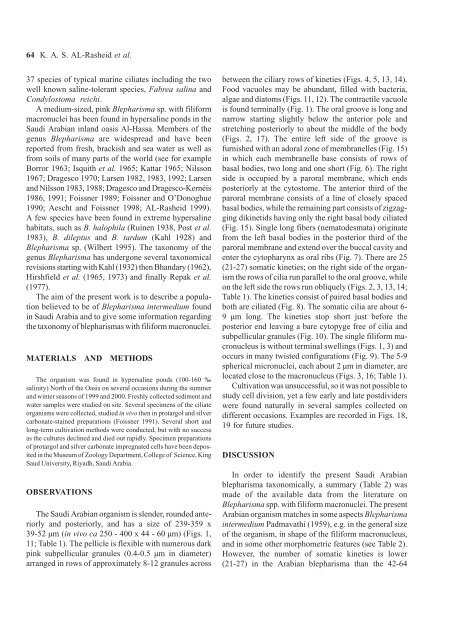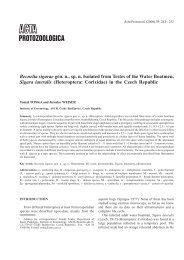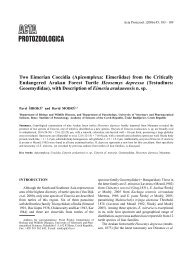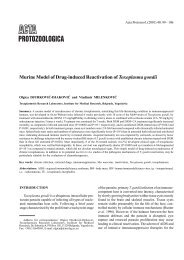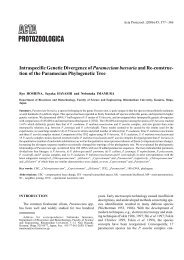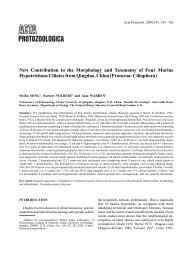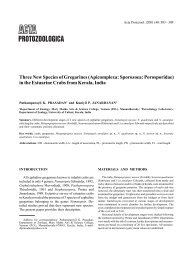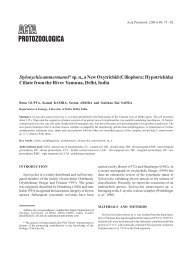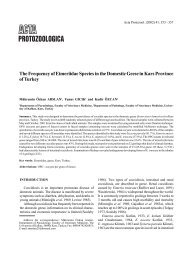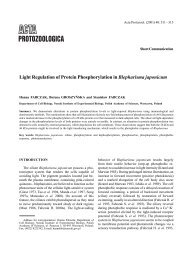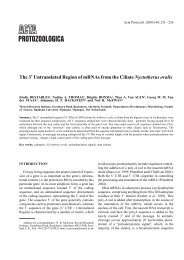Blepharisma intermedium Padmavathi, 1959 (Ciliophora ...
Blepharisma intermedium Padmavathi, 1959 (Ciliophora ...
Blepharisma intermedium Padmavathi, 1959 (Ciliophora ...
Create successful ePaper yourself
Turn your PDF publications into a flip-book with our unique Google optimized e-Paper software.
64 K. A. S. AL-Rasheid et al.<br />
37 species of typical marine ciliates including the two<br />
well known saline-tolerant species, Fabrea salina and<br />
Condylostoma reichi.<br />
A medium-sized, pink <strong>Blepharisma</strong> sp. with filiform<br />
macronuclei has been found in hypersaline ponds in the<br />
Saudi Arabian inland oasis Al-Hassa. Members of the<br />
genus <strong>Blepharisma</strong> are widespread and have been<br />
reported from fresh, brackish and sea water as well as<br />
from soils of many parts of the world (see for example<br />
Borror 1963; Isquith et al. 1965; Kattar 1965; Nilsson<br />
1967; Dragesco 1970; Larsen 1982, 1983, 1992; Larsen<br />
and Nilsson 1983, 1988; Dragesco and Dragesco-Kernéis<br />
1986, 1991; Foissner 1989; Foissner and O’Donoghue<br />
1990; Aescht and Foissner 1998; AL-Rasheid 1999).<br />
A few species have been found in extreme hypersaline<br />
habitats, such as B. halophila (Ruinen 1938, Post et al.<br />
1983), B. dileptus and B. tardum (Kahl 1928) and<br />
<strong>Blepharisma</strong> sp. (Wilbert 1995). The taxonomy of the<br />
genus <strong>Blepharisma</strong> has undergone several taxonomical<br />
revisions starting with Kahl (1932) then Bhandary (1962),<br />
Hirshfield et al. (1965, 1973) and finally Repak et al.<br />
(1977).<br />
The aim of the present work is to describe a population<br />
believed to be of <strong>Blepharisma</strong> <strong>intermedium</strong> found<br />
in Saudi Arabia and to give some information regarding<br />
the taxonomy of blepharismas with filiform macronuclei.<br />
MATERIALS AND METHODS<br />
The organism was found in hypersaline ponds (100-160 ‰<br />
salinity) North of the Oasis on several occasions during the summer<br />
and winter seasons of 1999 and 2000. Freshly collected sediment and<br />
water samples were studied on site. Several specimens of the ciliate<br />
organisms were collected, studied in vivo then in protargol and silver<br />
carbonate-stained preparations (Foissner 1991). Several short and<br />
long-term cultivation methods were conducted, but with no success<br />
as the cultures declined and died out rapidly. Specimen preparations<br />
of protargol and silver carbonate impregnated cells have been deposited<br />
in the Museum of Zoology Department, College of Science, King<br />
Saud University, Riyadh, Saudi Arabia.<br />
OBSERVATIONS<br />
The Saudi Arabian organism is slender, rounded anteriorly<br />
and posteriorly, and has a size of 239-359 x<br />
39-52 µm (in vivo ca 250 - 400 x 44 - 60 µm) (Figs. 1,<br />
11; Table 1). The pellicle is flexible with numerous dark<br />
pink subpellicular granules (0.4-0.5 µm in diameter)<br />
arranged in rows of approximately 8-12 granules across<br />
between the ciliary rows of kineties (Figs. 4, 5, 13, 14).<br />
Food vacuoles may be abundant, filled with bacteria,<br />
algae and diatoms (Figs. 11, 12). The contractile vacuole<br />
is found terminally (Fig. 1). The oral groove is long and<br />
narrow starting slightly below the anterior pole and<br />
stretching posteriorly to about the middle of the body<br />
(Figs. 2, 17). The entire left side of the groove is<br />
furnished with an adoral zone of membranelles (Fig. 15)<br />
in which each membranelle base consists of rows of<br />
basal bodies, two long and one short (Fig. 6). The right<br />
side is occupied by a paroral membrane, which ends<br />
posteriorly at the cytostome. The anterior third of the<br />
paroral membrane consists of a line of closely spaced<br />
basal bodies, while the remaining part consists of zigzagging<br />
dikinetids having only the right basal body ciliated<br />
(Fig. 15). Single long fibers (nematodesmata) originate<br />
from the left basal bodies in the posterior third of the<br />
paroral membrane and extend over the buccal cavity and<br />
enter the cytopharynx as oral ribs (Fig. 7). There are 25<br />
(21-27) somatic kineties; on the right side of the organism<br />
the rows of cilia run parallel to the oral groove, while<br />
on the left side the rows run obliquely (Figs. 2, 3, 13, 14;<br />
Table 1). The kineties consist of paired basal bodies and<br />
both are ciliated (Fig. 8). The somatic cilia are about 6-<br />
9 µm long. The kineties stop short just before the<br />
posterior end leaving a bare cytopyge free of cilia and<br />
subpellicular granules (Fig. 10). The single filiform macronucleus<br />
is without terminal swellings (Figs. 1, 3) and<br />
occurs in many twisted configurations (Fig. 9). The 5-9<br />
spherical micronuclei, each about 2 µm in diameter, are<br />
located close to the macronucleus (Figs. 3, 16; Table 1).<br />
Cultivation was unsuccessful, so it was not possible to<br />
study cell division, yet a few early and late postdividers<br />
were found naturally in several samples collected on<br />
different occasions. Examples are recorded in Figs. 18,<br />
19 for future studies.<br />
DISCUSSION<br />
In order to identify the present Saudi Arabian<br />
blepharisma taxonomically, a summary (Table 2) was<br />
made of the available data from the literature on<br />
<strong>Blepharisma</strong> spp. with filiform macronuclei. The present<br />
Arabian organism matches in some aspects <strong>Blepharisma</strong><br />
<strong>intermedium</strong> <strong>Padmavathi</strong> (<strong>1959</strong>), e.g. in the general size<br />
of the organism, in shape of the filiform macronucleus,<br />
and in some other morphometric features (see Table 2).<br />
However, the number of somatic kineties is lower<br />
(21-27) in the Arabian blepharisma than the 42-64


